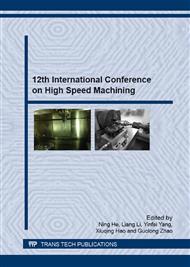p.3
p.13
p.20
p.29
p.36
p.43
p.48
p.56
Effect of Spindle Speeds on 3D Topography of Ball-End Milled Surfaces Using Wavelet Analysis Method
Abstract:
Optical profiler is employed to acquire topography height data of ball-end milled die steel surface under different spindle speeds ranging from 2000rpm to 12000rpm with lead angle of 20° and tilt angle of-10°. By multi-scale wavelet analysis, measured height data are decomposed and then been reconstructed, meanwhile 3D topography and 3D roughness in different frequency bands are obtained. The results show that the changing trend of roughness with frequency band under different spindle speeds is not the same. In the high frequency bands, roughness has a tendency to increase with the increasing spindle speed. In the median frequency band, the roughness of the surface machined under low spindle speed 2000 rpm is the largest and the roughness of the surface machined under high spindle speed 12000 rpm is the lowest. In the low frequency bands, the roughness of the surface machined under low spindle speed 2000rpm is much larger than those obtained under other spindle speeds, and with the increasing spindle speed, the changing trend of roughness increases firstly then decreases.
Info:
Periodical:
Pages:
13-19
Citation:
Online since:
January 2016
Authors:
Keywords:
Price:
Сopyright:
© 2016 Trans Tech Publications Ltd. All Rights Reserved
Share:
Citation:


